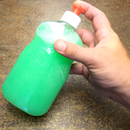Introduction: Simple Flip Flop Circuit
In this Instructable I show you how to make a Flip Flop LED circuit. The special thing about this circuit is that it does not use an IC (Integrated Circuit).
By using different resistors, capacitors and transistors, I succeeded in this project to make a circuit that lights the LED lights one by one.
I will explain how the circuit works in the last step.
Video Tutorial
Supplies
- 2 LED lights (any color you want)
- 2 BC547 transistors
- 2 470 Ohm resistors
- 2 10K resistors
- 2 100 uF capacitors
Step 1: Prepare 470 Ohm Resistors
For this step you need 2 470 ohm resistors. Bend one pin of both resistors 90 degrees. Then solder the bent pins together.
It doesn't matter how a resistor is placed, it works the same in both directions.
Step 2: Mount the 10K Resistors.
For this step you need the 2 10K resistors. Cut a piece off the pin on one side of both resistors. Then solder the resistors to the 2 resistors from the previous step.
The resistors from this step do not necessarily have to be 10K. As long as they are anywhere between 10K and 50K it is fine. (speed of changeover is therefore also different)
Step 3: Mount the First Transistor
Bend the collector and emitter terminals of the BC547 transistor 90 degrees. Solder the Collector to the 470 Ohm resistor and the Base to the 10K resistor.
The last image is the pinout of the BC547 transistor.
Step 4: Mount the Second Transistor
Bend the collector and emitter terminals of the BC547 transistor 90 degrees. Solder the Collector to the 470 Ohm resistor and the Base to the 10K resistor.
Step 5: Mount the LED Lights
Bend the connectors of the LED lights so that they are at an angle of 90 degrees. Solder the anode (+) of the first LED to one of the pins that are still free from the BC547 transistors (emitter).
Then solder the anode of the second LED to the other transistor.
Connect the cathodes (-) of both LED lights together by soldering them.
Step 6: Mount the Capacitors
For this project I used 100 uF capacitors. Between 10 uF and 100 uF works in any case (interval of the LED lamps changes with it)
Mount the first capacitor with the + connection between "transistor 1 and the 470 Ohm resistor" and with the - connection between "transistor 2 and the 10K resistor".
Mount the second capacitor with the + connection between "transistor 2 and the 470 Ohm resistor" and with the - connection between "transistor 1 and the 10K resistor".
Step 7: Mount the Power Supply
The circuit is finished so far. Only the power supply needs to be connected. I used a 9V battery for that.
Connect the + connection of the battery clip to the connection of the 4 resistors.
Connect the - connection of the battery clip to the connection between the 2 LED lamps.
Connect the 9V battery to the connector.
Step 8: Ready
The Flip Flop circuit is ready!
How it works
The base of both the transistors are connected to + connection through resistor. Any one transistor will get activated first. (this is because no transistor is exactly similar to other one). Lets assume transistor 1 turns on first. When the transistor turns on the collector pin gets grounded and led at its collector lights up. Also the capacitor starts to charge through ground provided by 1st transistor and the 10k resistor at the base of 2nd transistor. Since the 1st capacitor is charging it is taking current from the 10k resistor which is at the base of 2nd transistor. The base of 2nd transistor has no current to activate its led. At some point 1st capacitor will charge up. And when it does so, there is no more current flowing through it. Now there is enough current that can flow through base of 2nd transistor. The 2nd transistor gets activated. (Including the led connected to its collector).
Video Tutorial
I am curious about your creations, comments and additions!
See you soon.
New Pew

Participated in the
Anything Goes Contest











